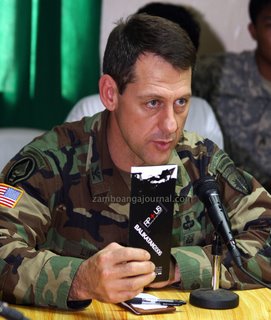
U.S. Army Colonel James Linder during a meeting with Filipino government officials in the southern Philippine island of Jolo. Linder, more popular with the local press as "G.I. Joe" named after a popular cartoon hero, is perhaps one of the most friendly U.S. military commander deployed in the southern Philippines and is active in humanitarian efforts in the troubled region. (Zamboanga Journal)
HONOLULU (Audrey McAvoy) When the commander of U.S. Special Forces in the Philippines talks about battles won in the war on terror, he does not list enemies killed and targets destroyed. Instead, U.S. Army Col. James Linder recounts jobs created and schools built.
"We just changed the dynamics of a very small community from one in which only a few years ago, Abu Sayyaf was coming down from the hilltop with weapons on their back and recruiting the schoolchildren, to one in which they can't come there anymore,'' Linder said.
Since 2002, U.S. Army Rangers and Navy SEALs have been training and equipping Philippine troops to oust al-Qaida-linked Abu Sayyaf terrorists from Mindanao, a predominantly Muslim and largely poor part of the Southeast Asian nation. The militaries have used a combination of combat offensives and development projects with a heavy emphasis on the latter to isolate the terrorists and win over local populations.
Their successes in villages like the one Linder described contrast sharply with the U.S.-led effort in Iraq or Afghanistan, where terror attacks only seem to increase. Now, senior U.S. military leaders say their work in the Philippines may offer lessons for how the U.S. operates in the Middle East.
On Basilan island, where U.S. troops first started operating four years ago, improved security has allowed the Philippine military to shrink its presence from 15 battalions to two, said Maj. Gen. David Fridovich, the commander of U.S. Special Forces in the Pacific.
Fridovich said military operations are only 15 percent of what needs to be done. The rest is humanitarian, like Army engineers helping rebuild schools and military doctors giving residents shots. U.S. aid workers have helped build bridges and roads.
``We think there is a model here that's worth showcasing. There's another way of doing business,'' Fridovich told reporters at the Pacific Area Special Operations Conference in Honolulu recently.
Of course, circumstances in the Philippines are far different from the Middle East. Disparate cultures, history and geography would prevent any Philippine solution from being applied directly to either Iraq or Afghanistan.
Also, the U.S. and Philippine militaries can't take credit for all of Abu Sayyaf's failures. The group has marginalized itself by offending local populations with the use of tactics like beheadings, rape and torture.
But Linder, speaking on the sidelines of an anti-terror conference in Hawaii, said his interactions with people on the island of Jolo showed the troops are making a difference.
He recalled a visibly emotional woman who ran up to him because she wanted to show her gratitude for the sewing machine that has allowed her to earn a living. And the village leader who vowed to quit fighting for Abu Sayyaf and instead take up arms alongside Filipino soldiers against his former allies.
Rohan Gunaratna, head of terrorism research at the Singapore-based Institute of Defense and Strategic Studies, said the U.S. has had ``tremendous success'' on Basilan.
"The Americans did not take the shortcut in Basilan. They took the long road that's working with civilians. Their priority was to build bridges with the Muslim public rather than hunt the terrorists,'' Gunaratna said.
Iraq only became so violent because U.S. commanders focused too much energy on killing enemies when they should have done more to meet the basic needs of Iraqis, he said.
"The terrorists are also competing for the hearts and the minds of the people,'' Gunaratna said. "If you are able to do a better job, the terrorists are marginalized. No one will support the terrorists.''
The U.S. military effort in the Philippines has not been easy.
U.S. troops now numbering a few hundred, down from a peak of 1,200 do not participate in combat there. The U.S. military initially wanted to fight but President Gloria Macapagal Arroyo's shaky administration refused to gamble with the politically explosive prospect of foreign troops fighting domestic insurgents on Philippine soil.
Still, nearly a dozen American troops died in a helicopter crash and a bomb attack in 2002. Muslim activists and residents have protested the U.S. presence, calling it a magnet for violence and a violation of Philippine sovereignty.
A few hundred mountain-based guerrillas continue to threaten Jolo. In March, suspected Abu Sayyaf members bombed a grocery store on the southern island, killing nine people.
Washington and Manila, meanwhile, are deepening their partnership. Last week, the two nations announced a new security arrangement expanding the grounds for American forces to stage exercises in the Philippines.
When asked if the Basilan experience was applicable to Iraq and Afghanistan, Gen. Bryan D. Brown, head of U.S. Special Operations Command, said every culture and situation was different, but many lessons could be learned.
"It's about working with the people, it's about building the infrastructure, it's about demonstrating good governance,'' Brown told reporters at the Hawaii conference. "It's about good medical care, it's about eliminating human suffering.'' (We are republishing this AP story because we are a witness to the transformation of Basilan after the Balikatan -- from one strife-torn island, now to a peaceful destination in the southern Philippines -- of course, local military commanders headed by Brig. Gen. Alexander Aleo, the government officials and the Muslim people helped a lot to make this come true. Ed. Zamboanga Journal)
No comments:
Post a Comment